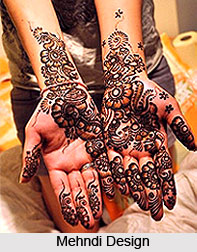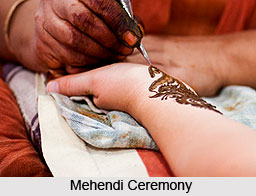 Mehendi is yet another pre wedding ceremony, traditional in India. In India, a lot of prominence is given on traditions and rituals. Indian people are passionate lovers of splendor and elegance. This is what reflects in the Mehendi ceremony just before the day of marriage. Mehendi ceremony has been prevailing since ages and forms such an essential part of the wedding ceremony that it cannot be imagined without it. Furthermore, Mehendi is one of the sixteen adornments of the bride and her beauty is thought to be incomplete without it.
Mehendi is yet another pre wedding ceremony, traditional in India. In India, a lot of prominence is given on traditions and rituals. Indian people are passionate lovers of splendor and elegance. This is what reflects in the Mehendi ceremony just before the day of marriage. Mehendi ceremony has been prevailing since ages and forms such an essential part of the wedding ceremony that it cannot be imagined without it. Furthermore, Mehendi is one of the sixteen adornments of the bride and her beauty is thought to be incomplete without it.
Mehendi ceremony usually takes place just before marriage. According to the ritual, the bride does not step out of the house after puts on mehendi in her hands and feet. Mehendi ceremony is essentially planned by the family of the bride and is usually a private affair that takes place in the attendance of friends, relatives and family members. However, the scale of the ceremony depends upon individual choice. Some people celebrate it with great spectacle. In most cases, the Mehendi ceremony is very similar to the pre wedding ceremony sangeet ceremony.
During the ceremony, turmeric paste is applied on bride`s face, feet and hands. After this, the Mehendi function begins. For applying Mehendi to the bride, a skilled Mehendi expert is called upon. He applies Mehendi on bride`s hands, arms, feet and legs. Traditionally, the Mehendi is applied to the bride and is obtained by drying the leaves of the Henna plant. However, nowadays there are various kinds of Mehendi designs available in the market. Some of the popular Mehendi designs include Rajasthani Mehendi, Arabic Mehendi, Tattoo Mehendi, Crystal Mehendi and so on.
Thus it is proved that Mehendi has become more of an accessory than a necessity. However, no matter whatever might be its form, mehendi is still an indispensable element of the bride. According to popular belief, the darker the color of the Mehendi, the more her husband will be loving the wife. As a tradition, the bride is not allowed to work in her in laws house till the time her Mehendi does not fade away. This ceremony is primarily a women function and it takes place amidst musical beats of Dholak, with women singing customary songs for a well-to-do marital life of the bride.
The occasion of Mehendi is fun a filled ritual, which is celebrated mainly by the bride`s family. Today in our Hindu culture weddings are no more an ordinary affair with only get together parties of the family members and friends. But it is celebrated in a much more larger scenario than earlier. It is a lavish and elaborate affair in present days. So pre wedding functions are no more restricted to a private affair but the entire locality is invited to it. It is celebrated with equal fun and zeal as the main wedding.

Different regions of the country celebrate the mehendi ceremony in different manner. The procedure varies according to their own marriage customs, rituals, manner of dress and culture. The celebration also depends on the wealth and status of the people. The bride`s family bears the expenses of the Mehendi party. The ceremony is mostly held at bride`s place or sometimes in a banquet hall on the eve of the marriage ceremony or few days just before the marriage.
The female relatives and friends of the girl attend the party. It is actually a ladies party. The female friends and relatives apply turmeric paste on the bride`s body and face to bring out the real glow of her complexion. A relative or a mehndiwali who knows the art to apply mehendi is called upon to put mehendi on the hands and feet of the bride. The event has a festive feeling within it. The women sing and dance traditional songs on mehendi ritual. The bride wears light color clothes and light jewelry. According to the custom the bride is not allowed to step out of the house after the mehendi ritual until her marriage. The bride`s female cousins sometimes apply a dot of mehendi on the palm of the groom.
The mehendi celebration is filled with fun and enjoyment as the family members and friends gathers to celebrate this lovely occasion. Not only the bride apply henna paints on her hand and feet but her friends and relatives also paints their hands with intricate and beautiful designs of henna paste or mehendi. Professional henna artists are called upon to painstakingly work out the intricate details and beautiful designs on the bride`s hands and feet.
Conventional bridal patterns include peacocks and paisleys that symbolize passion. It is believed that the darker and deeper the henna stains the more the mother-in-law and husband will love her new daughter-in-law and wife respectively. The stain also depends on the quality of the henna being used. While the henna is applied on the bride`s hand and feet, rest of the female members sing song and dance to celebrate the occasion. The ritual of mehendi signifies the strength and power of love in a marriage so it is regarded good omen if the bride keeps it as long as possible. The party ends with a dinner party for the family members, relatives and friends.
Simultaneously, with mehendi the ritual of haldi is also executed in some regions and it is called the haldi ceremony where a day before the wedding, haldi paste is applied to the bride by her female relatives and friends. In some of the castes it is celebrated together with the mehendi ceremony and in some caste it is celebrated the day before the wedding in that case the mehendi ceremony is conducted a couple of days before the marriage. The haldi ceremony is held in both bride and groom`s place. In the groom`s house female relatives of the groom apply haldi on him and bath him with water. This ritual is meant to sheer the groom of shyness and is believed as a good omen.
More on Steps in a Indian Marriage Ceremony
More on Indian Wedding Accessories
More on Indian Religious Weddings
More on Types of Marriages
See also
 Mehendi is yet another pre wedding ceremony, traditional in India. In India, a lot of prominence is given on traditions and rituals. Indian people are passionate lovers of splendor and elegance. This is what reflects in the Mehendi ceremony just before the day of marriage. Mehendi ceremony has been prevailing since ages and forms such an essential part of the wedding ceremony that it cannot be imagined without it. Furthermore, Mehendi is one of the sixteen adornments of the bride and her beauty is thought to be incomplete without it.
Mehendi is yet another pre wedding ceremony, traditional in India. In India, a lot of prominence is given on traditions and rituals. Indian people are passionate lovers of splendor and elegance. This is what reflects in the Mehendi ceremony just before the day of marriage. Mehendi ceremony has been prevailing since ages and forms such an essential part of the wedding ceremony that it cannot be imagined without it. Furthermore, Mehendi is one of the sixteen adornments of the bride and her beauty is thought to be incomplete without it.


















